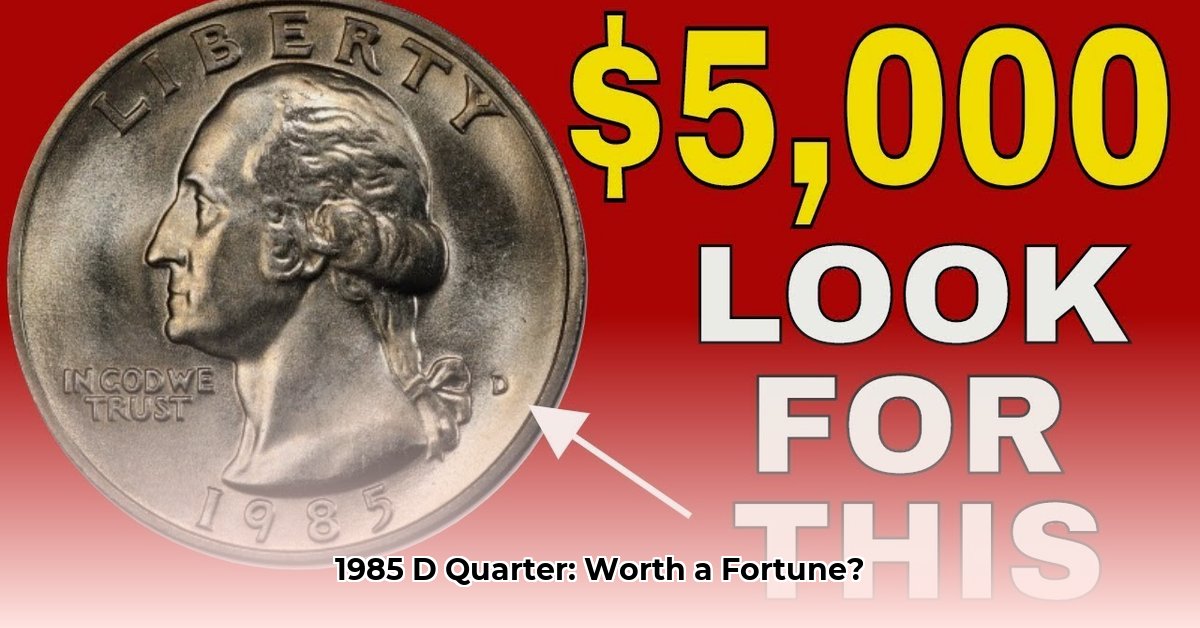
Unlocking the hidden worth of your 1985-D quarter can be surprisingly rewarding! But how much is it really worth? The answer isn't simple; a coin's value depends heavily on three key factors: its condition (grading), its mint mark (where it was made), and the presence of any minting errors. For more on precious metal values, check out this helpful resource on silver prices. Let's explore each factor to help you determine your quarter's potential value.
Understanding Coin Grading: The Sheldon Scale
Coin grading determines a coin's condition, directly impacting its value. Numismatists (coin experts) primarily use the Sheldon Scale, a system ranging from Poor (1) to Mint State (70). Higher numbers reflect better condition and, consequently, higher value.
Common Grades and Their Visual Characteristics
- Poor (G): Severely worn; significant damage and loss of detail.
- Very Good (VG): Shows considerable wear, but major design elements remain visible.
- Fine (F): Moderate wear; most details are still clear.
- Very Fine (VF): Minor wear; details are sharp and well-defined.
- Extremely Fine (EF): Minimal wear; appears almost uncirculated.
- About Uncirculated (AU): Shows very faint signs of wear; mostly mint-like condition.
- Mint State (MS): Perfect condition; no visible wear. Subgrades like MS60, MS65, and MS70 denote increasingly better condition within the Mint State range.
Important Note: Grading involves subjectivity. Two graders might slightly disagree. For high-value coins, professional grading from reputable services like PCGS (Professional Coin Grading Service) or NGC (Numismatic Guaranty Corporation) is crucial for accurate valuation.
Mint Marks: P, D, and S – Location, Location, Location
The tiny letter on your quarter (P, D, or S) indicates its mint of origin: Philadelphia (P), Denver (D), or San Francisco (S). Mint marks influence value due to variations in mintage numbers. While the difference is often slight for common date quarters, a knowledgeable collector might pay a premium for a rarer mint mark. For the 1985 quarter, the 'D' mint is slightly less common than 'P', and the 'S' mint is notably less common, which can affect the value.
Minting Errors: When Imperfection Equals Value
Minting errors, while unintentional, can significantly increase a coin's value. These errors arise from imperfections during the striking process.
Common Errors and Their Valuation Impact
- Doubled Dies: Parts of the design appear doubled or blurry due to a flaw in the die itself.
- Off-Center Strikes: The coin's design is not centrally aligned.
- Broad Strikes: The coin was struck with excessive force, resulting in flattened details.
The rarity and visibility of the error directly impact its value. Authenticating a claimed error is critical.
Determining Your 1985-D Quarter's Value: A Step-by-Step Guide
To estimate your 1985-D quarter's value, follow these steps:
- Assess Condition: Carefully examine your quarter and assign a grade using the Sheldon Scale. Use online images for comparison.
- Identify Mint Mark: Locate the "D" to confirm it was minted in Denver.
- Check for Errors: Look for any minting anomalies.
- Consult Price Guides: Use online resources (with caution) and reputable numismatic publications to find estimated values. Remember, these are just estimates, and market conditions constantly change.
- Professional Grading (Optional but Recommended for High-Value Coins): For higher-grade or error coins, professional grading ensures accurate and objective valuation.
Isn't it fascinating how the value of a seemingly ordinary coin can fluctuate so dramatically?
Estimated Value Ranges for a 1985-D Quarter
These are rough estimates and can vary considerably; market demand, specific error types, and grading discrepancies heavily influence actual value.
| Grade | Estimated Value Range (USD) |
|---|---|
| Poor (G) | $0.25 - $1 |
| Very Good (VG) | $1 - $3 |
| Fine (F) | $3 - $5 |
| Very Fine (VF) | $5 - $10 |
| Extremely Fine (EF) | $10 - $25 |
| About Uncirculated (AU) | $25 - $50 |
| Mint State (MS60) | $50 - $100+ |
| Mint State (MS65) | $100+ |
Where to Buy, Sell, or Get Your Coins Graded
Numerous online marketplaces, coin shops, and auction houses exist. Always do thorough research to ensure legitimacy and authenticity. For professional grading, consider PCGS or NGC.
Remember: This guide is for informational purposes; consult with a professional numismatist for accurate valuation, especially for high-value coins.